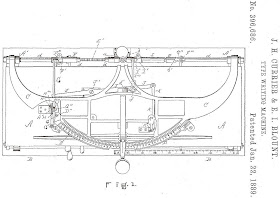SEPTEMBER 3
BIKING
(or rowing?)
TO THE BOSTON
TYPEWRITER
Use a bike with a roller bearing wheel? Same typewriter guy. Take a water bottle with a screw top? Same guy again.
Go there on roller skates? Yep, same guy!
Did the doors have pneumatic checking hinges? Another typewriter guy invented those.
But the gym would have been way too modern to have those cash carrying systems some of us remember from department stores back in the “good old days”. Anyway, same two typewriter guys invented that, too.
Same typewriter guys, same typewriter: the Boston:
Daniel Edgar Kempster, of Boston, first patented the Boston typewriter in 1884. It was, at that stage, a joint effort with Willard Herbert Gilman.
Then Kempster patented improvements on his own in 1886.
Three years later, Eugene Irvin Blount and James Henry Currier, both of Somerville, Massachusetts, got in on the act and patented further improvements to Kempster’s design.
Kempster became associated with Blount and Currier through Gilman, who ran a manufacturing company in Maine and for whom Blount designed cash carrier equipment.
Finally, on this day in 1889, Kempster, Blount, Currier and Benjamin Dore, of Lynn, Massachusetts, jointly patented the produced version.
The image of the Boston typewriter here comes from the collection of Anthony Casillo.
Anthony says the Boston’s name cast into a pediment is reminiscent of Neoclassical Greek architecture. “For an index typewriter, which was typically designed to be simple and inexpensive, the Boston was a complex writing machine."
It is not to be confused with another typewriter marketed as the Boston, which was a variation of a extremely simple and inexpensive machine, the World.
Daniel Edgar Kempster gets most of the credit for the Boston, so we will look at him first. He was born in Maine in 1843, and at one time described himself a machinist. Among his many inventions were the spring-balance shade roller (1880), roller skates, a copying press and a cash and parcel carrier (all in 1885), a colour printing machine (1887), folding convertible chair (1889), screw-top bottle (1894) and the roller bearing trolley wheel (1901).
Blount has been described as one of the “most prominent pioneers” among liquid door closers. “There is no record of a liquid closer being produced before Blount's version,” says a liquid closer historian (?!). It is said Blount began to manufacture the closers in Portland, Maine in 1883. Blount won a Franklin Institute merit award for his door check in 1902.
Currier, born in Enfield, Grafton, New Hampshire, in April 1833, was a manufacturer who made one of the early toy “organettes”, designed by Albert Andrew McIntire. Currier died at Somerville, Massachusetts, on April 1, 1902.
Benjamin Dore was also from New Hampshire. He was born at Belknap, Alton, in January 1833 and became a prominent shoe manufacturer in Lynn, Massachusetts. Dore died on December 1, 1908.
The Boston typewriter, however, did not quite die with the limited numbers produced via the Kempster-Blount-Currier-Dore patent.
In this series on July 14, I mentioned a so-called “one-finger typewriter” designed by Frederic Webster Howe, the famous gun maker, in 1891.
The Howe typewriter was directly based on the Boston. It was, Howe said, his attempt to “perfect” the Kempster typewriter.
Howe, based in Providence, Rhode Island, became a consulting engineer in his later life and had contact with Dore through Howe’s shoe making machines.
At the time of that July 14 post, Richard Polt commented, "That Howe machine looks very attractive." To which I replied, "I don't suppose it looks like anything that WAS made?" Unbeknown to either of us at the time, the Howe had already been made - as the Boston!
That same year, in another Antique Typewriters, Darryl Rehr wrote:
One William Cahoon junior, of Little Rock, Arkansas, was issued with a patent for a “segmental type-disk” typewriter - on this day in 1889 as well. He assigned it to E. L. Lefevre, later of Dayton and famous for inventing the New Era Auto-Cycle.
I don’t much about Mr Cahoon, or what became of his interesting typewriter. However, Cahoon’s wife, Haryot Holt Hamblin Cahoon, was a famous and pioneering Little Rock journalist, a leading US women’s rights activist and an author. In 1893 she wrote the collection of essays called What One Woman Thinks.
Haryot Holt Hamblin was born in Niles, Berrien, Michigan, on February 6, 1857, and married William Cahoon Jnr in Wayne County, Michigan, in 1876.
The marriage either failed or William Cahoon died, because in 1898 Haryot married the Nick Carter author, Frederic Van Rensselaer Dey (1865-1922). As Mrs Dey, Haryot continued to write, but under the name Haryot Holt Dey.
Last week notagain and Ted commented that this series reminded them of James Burke’s 1980s TV show Connections. I take that as a huge compliment, because I used to absolutely love that show. Anyway, I think we’ve made some more interesting connections today …






























Masterfully done! The "On This Day" series is very much like James Burke's "Connections", except far more specifically linking typewriter inventors and designs to surprising objects still in use today. Today's article is the best example so far. Keep up the great writing and making those connections! (:
ReplyDeletespeaking of connections, my journey to update the Victor page at TWDB has led me to the Victor Index, then to the World and finally to the Boston, which now has its own page and for which this post is now a reference, 5 years later. (:
ReplyDeletehttp://typewriterdatabase.com/boston.845.typewriter-serial-number-database